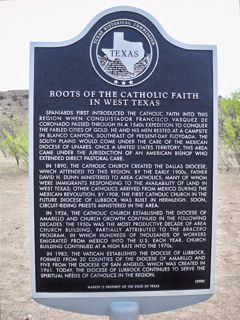Roots of the Catholic Faith in West Texas

Address: 25 mi. E on FM 97; 5 mi. N on FM 1065
Directions: 8 miles south of Floydada on US 62 in roadside park
Marker #: Unknown
Year Dedicated: 2008
Size, type: 27" x 42" Subject
Last reported condition: Good
Roots of the Catholic Faith in West Texas
Spaniards first introduced the Catholic faith into this region when Conquistador Francisco Vasquez De Coronado passed through in a 1540’s Expedition to conquer the fabled cities of gold. He and his men rested at a campsite in Blanco Canyon, southeast of present-day Floydada. The South Plains would come under the care of the Mexican Diocese of Linares. Once a United States Territory, this area came under the jurisdiction of an American Bishop who extended direct pastoral care.
In 1890, the Catholic Church created the Dallas Diocese, which attended to this region. By the early 1900’s, Father David H. Dunn ministered to area Catholics, many of whom were immigrants responding to the availability of land in West Texas; other Catholics arrived from Mexico during the Mexican revolution. By 1908, the first Catholic Church in the future Diocese of Lubbock was built in Hermleigh. Soon, circuit-riding Priests ministered in the area.
In 1926, the Catholic Church established the Diocese of Amarillo and church growth continued in the following decades. The 1950’s was the most productive decade of area church building, partially attributed to the Bracero Program, in which hundreds of thousands of workers emigrated from Mexico into the U.S. each year. Church building continued at a high rate into the 1970’s.
In 1983, the Vatican established the Dioceses of Lubbock, formed from 20 counties of the Diocese of Amarillo and five from the Diocese of San Angelo, which was created in 1961.
Today, the Diocese of Lubbock continues to serve the spiritual needs of Catholics in the region. (2008)
Decimal degrees: 33.892250, -101.360372
Degrees, minutes: N 33 53 32.1 W 101 21 37.3

